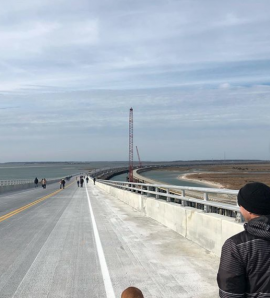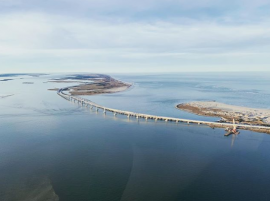Bigger, Better, Stronger | The Replacement for the Bonner Bridge Opens
As grand opening go, there wasn’t much of anything to let the public know the replacement for the Bonner Bridge was open to traffic. Just a brief press release from NCDOT with a head line reading, “New Bridge Over Oregon Inlet Opens to Traffic.”
But if the announcement was anticlimactic, the bridge is not.
Higher, wider, sturdier, everything about this new bridge across Oregon Inlet cries out that this is a big improvement over its predecessor.
We had an inkling of what was to come when NCDOT opened the bridge for foot and bicycle traffic for one day last month. That was a pretty spectacular event, and a few thousand people braved a very stiff north wind to take advantage of the offer.

Walking across the 2.8 mile span yielded a remarkable bird’s eye view of what has been accomplished. The sheer size of the bridge compared to the Bonner Bridge is perhaps what is most evident. The vertical clearance of the new bridge is 90’ and that does not include the extra height from the decking and spans. The new bridge truly seems to dwarf the old one.
The first time driving across the bridge is thrilling. That feeling will, no doubt, fade over time, sort of like scent of a new car two or three months after purchase, but for the time being it is very exciting driving across the bridge.
That feeling may be due, at least in part, to how much safer it seems.
It is certainly wider; there were no shoulders on the original bridge. This bridge has 12-foot-wide travel lanes and 8-foot-wide shoulders. Those shoulder could certainly accommodate bicyclers, but they also contribute to safety.
It is also noticeably stronger and seems to be better engineered. Hopefully that is the case, because it is projected to have a 100 year lifespan.
It took a long time to get to this point. When the Bonner Bridge opened to traffic in 1963, its design life was 30 years. When 1993 came, the first of the lawsuits began, and they continued through 2003 and 2013. It wasn’t until August of 2015 that the lawsuits were resolved.
The continual delay of a project that Outer Banks residents and visitors knew had to move forward was frustrating and at time maddening. Yet in an odd way, those delays may have been a blessing in disguise.
The bridge that has emerged is an engineering marvel. Some of the design and construction techniques were not available in 1993 or even 2003.
One feature that is unlike most bridges are new formulations of concrete which, according to NCDOT, “… is the primary reason for the bridge’s increased life span.”

The concrete is reinforced with stainless steel “… which will provide additional protection against corrosion from salt water penetrating into key concrete components of the bridge. It also will reduce rehabilitation and maintenance costs,” NCDOT notes.
A few years ago, it was discovered that scour from the force of Oregon Inlet currents left some of the bents, or pilings, of the Bonner Bridge that the roadbed rest on quite literally floating in water. The bridge was closed immediately after the discovery and remained closed for about two weeks.
To combat that, the new bridge rests on pilings driven almost 140’ into the seabed. Engineers working on the project were not aware of any project had tried that before. In written comment about what it would take to pound pilings that deep into the ground, HDL, the design team for the bridge, wrote, “To our knowledge, no one has previously designed and built a foundation where piles had to be jetted and driven through nearly 140 feet of soil in a way that still provided adequate capacity after 84 feet of scour occurs…To vet our proposed method, we had international pile foundation experts peer-review and endorse the procedure.”
There were other design features that make this new span stand out. Rather than constantly battle with Oregon Inlet to stay within one channel, engineers created nine 350’ navigation spans.
Was it expensive? That’s probably a relative term. The final price tag will be somewhere in the neighborhood of $250 million, a very significant number, but spread over 100 years, probably not all that much.
There is still some work to be completed. NCDOT and the affected utility companies just moved the power lines from old bridge to the new. There may be some additional work that has to be done on that.
The biggest part of the project that is left will be dismantling the old Bonner Bridge. Plans call for the demolished girders and road surface to be cleaned and then taken to sea to create an artificial reef. On the Pea Island side, a 1000’ pier using the old bridge will remain.
The major construction project remaining on Pea Island is the Jug Handle that will bypass the S Curves north of Rodanthe. That project is well underway with construction cranes on the north and south ends. The bridge is projected to be ready for traffic some time in 2020.
The new Oregon Inlet bridge has not yet been named. The North Carolina Legislature voted to name the bridge for longtime Dare County State Senator Mark Basnight, Senator Pro Tem until he retired. The Dare County Board of Commissioners supported the resolution but not unanimously. State law looks for a unanimous vote from local boards in naming bridges.
The official ribbon cutting for the bridge will be April 2.
